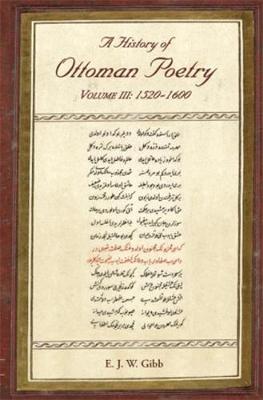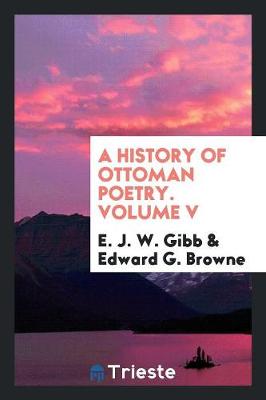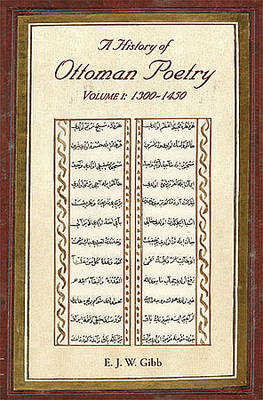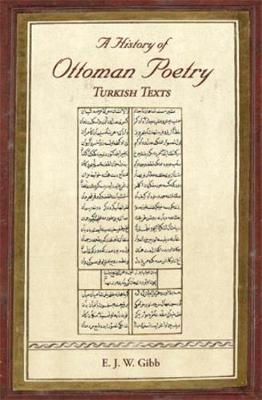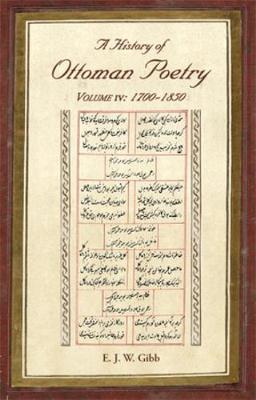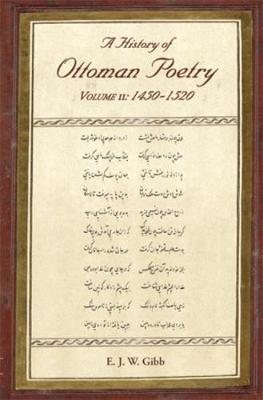Gibb Memorial Trust Turkish Studies
6 total works
The History of Ottoman Poetry, first published in six volumes between 1900 and 1909, was the principal product of E.J.W. Gibb's devotion to Ottoman Turkish literature. By the time of his early death in 1901 only the first volume had appeared in print. The remainder was almost complete and was seen through the press by Gibb's friend and literary executor, the Persian scholar E. G. Browne. The History was designed to provide the first extended account in English of Ottoman literature. The first four volumes cover four developmental phases, largely under the influence of Persian literature, from around 1300 to the middle of the nineteenth century. The fifth volume introduces the 'New School' of Ottoman poetry produced in Gibb's own era and inspired by French models. The sixth volume contains in Ottoman printed script the texts of all works quoted in English translation in the previous volumes. No comparable study has appeared in English since Gibb's magnum opus. His History of Ottoman Poetry has become a classic work which is still widely referred to and valuable for students, scholars and anyone with a general interest in Middle Eastern literature and culture.
Volume III (originally published 1904) covers both the second part of the'classical age' of Ottoman poetry, from 1520 to the early seventeenth century, and the subsequent 'late classical age' to c. 1700. In Gibb's understanding, this was the era of greatest Persian influence upon Ottoman poetry, and was at its most brilliant in the reign of Suleyman (1520-66). The majority of the most well known Ottoman poets flourished in these two centuries, drawn from all walks of life and many parts of the empire, from the chief jurisconsult Yahya Efendi (d. 1644) and the chief judge Baki (d. 1600), to the Nakshbandi sufi Lami'i Celebi of Bursa (d. 1531), Fuzuli of Baghdad (d. 1556), the Albanian-born soldier Yahya Bey (d. 1575), the satirist Nef'i from Erzurum (executed c. 1635), and the man of letters from Urfa, Nabi Efendi (d. 1712). In addition, eight of the most popular verse romances written in this period are summarised in an appendix.
Volume III (originally published 1904) covers both the second part of the'classical age' of Ottoman poetry, from 1520 to the early seventeenth century, and the subsequent 'late classical age' to c. 1700. In Gibb's understanding, this was the era of greatest Persian influence upon Ottoman poetry, and was at its most brilliant in the reign of Suleyman (1520-66). The majority of the most well known Ottoman poets flourished in these two centuries, drawn from all walks of life and many parts of the empire, from the chief jurisconsult Yahya Efendi (d. 1644) and the chief judge Baki (d. 1600), to the Nakshbandi sufi Lami'i Celebi of Bursa (d. 1531), Fuzuli of Baghdad (d. 1556), the Albanian-born soldier Yahya Bey (d. 1575), the satirist Nef'i from Erzurum (executed c. 1635), and the man of letters from Urfa, Nabi Efendi (d. 1712). In addition, eight of the most popular verse romances written in this period are summarised in an appendix.
The History of Ottoman Poetry, first published in six volumes between 1900 and 1909, was the principal product of E.J.W. Gibb's devotion to Ottoman Turkish literature. By the time of his early death in 1901 only the first volume had appeared in print. The remainder was almost complete and was seen through the press by Gibb's friend and literary executor, the Persian scholar E. G. Browne. The History was designed to provide the first extended account in English of Ottoman literature. The first four volumes cover four developmental phases, largely under the influence of Persian literature, from around 1300 to the middle of the nineteenth century. The fifth volume introduces the 'New School' of Ottoman poetry produced in Gibb's own era and inspired by French models. The sixth volume contains in Ottoman printed script the texts of all works quoted in English translation in the previous volumes. No comparable study has appeared in English since Gibb's magnum opus. His History of Ottoman Poetry has become a classic work which is still widely referred to and valuable for students, scholars and anyone with a general interest in Middle Eastern literature and culture.
Volume V (originally published 1907) concludes Gibb's study of Ottoman poetry. It contains three chapters on the'modern school of Ottoman poetry' drafted by him and edited by Browne. Emerging around 1860, this modern school was a product of the Ottoman tanzimat reform era and was strongly influenced by the 'inspiring genius' of western, particularly French, literary models. To Gibb, it signified 'a great awakening'. Chapter I provides a general introduction to the poets of the period and their literary and political circumstances. Chapter II is devoted to Sinasi Efendi (d. 1871), 'the master who laid the foundation of the new learning'; chapter III presents Ziya Bey, later Pasha (d. 1880), a prolific writer in both prose and verse and translator of many French literary works into Ottoman. Gibb died before he could begin an intended study of the person he considered the greatest poet of this new school, Namik Kemal (d. 1888).
Volume V contains over 100 pages of indices to all five volumes: of persons and places; of books, journals and poems; of'technical terms and Oriental words', and of subjects. The indices were compiled by R. A. Nicholson.
Volume V (originally published 1907) concludes Gibb's study of Ottoman poetry. It contains three chapters on the'modern school of Ottoman poetry' drafted by him and edited by Browne. Emerging around 1860, this modern school was a product of the Ottoman tanzimat reform era and was strongly influenced by the 'inspiring genius' of western, particularly French, literary models. To Gibb, it signified 'a great awakening'. Chapter I provides a general introduction to the poets of the period and their literary and political circumstances. Chapter II is devoted to Sinasi Efendi (d. 1871), 'the master who laid the foundation of the new learning'; chapter III presents Ziya Bey, later Pasha (d. 1880), a prolific writer in both prose and verse and translator of many French literary works into Ottoman. Gibb died before he could begin an intended study of the person he considered the greatest poet of this new school, Namik Kemal (d. 1888).
Volume V contains over 100 pages of indices to all five volumes: of persons and places; of books, journals and poems; of'technical terms and Oriental words', and of subjects. The indices were compiled by R. A. Nicholson.
The History of Ottoman Poetry, first published in six volumes between 1900 and 1909, was the principal product of E.J.W. Gibb's devotion to Ottoman Turkish literature. By the time of his early death in 1901 only the first volume had appeared in print. The remainder was almost complete and was seen through the press by Gibb's friend and literary executor, the Persian scholar E. G. Browne. The History was designed to provide the first extended account in English of Ottoman literature. The first four volumes cover four developmental phases, largely under the influence of Persian literature, from around 1300 to the middle of the nineteenth century. The fifth volume introduces the 'New School' of Ottoman poetry produced in Gibb's own era and inspired by French models. The sixth volume contains in Ottoman printed script the texts of all works quoted in English translation in the previous volumes. No comparable study has appeared in English since Gibb's magnum opus. His History of Ottoman Poetry has become a classic work which is still widely referred to and valuable for students, scholars and anyone with a general interest in Middle Eastern literature and culture.
Volume I (originally published 1900, during Gibb's lifetime) begins with an introduction on the origin, character and scope of Ottoman poetry, and provides an explanation of its principal verse forms and rhyme schemes. Gibb then discusses poets of the period 1300 to around 1450, considering this a formative era in which poetry was generally more'West-Turkish' in style and strongly influenced by local dialect than Ottoman later became. Foremost among the poets discussed are Sultan Veled (d. 1312), son of the revered mystic Celaleddin Rumi; Yunus Emre (fl. early 1300s), a master of 'rugged' mystical verse in the Turkish syllabic metre; and Suleyman Celebi (d. 1422) author of the Mevlid, a 'Hymn on the Prophet's Nativity' which acquired a central place in Turkish culture through its recital annually during celebrations on the birthday of the Prophet Muhammad. Gibb's method in all volumes is to supply biographical information on each writer, drawn primarily from Ottoman biographical dictionaries of poets, followed by English translations of some of their more significant poems and synopses of longer texts. For all these elements, a wealth of explanatory footnotes provides extra cultural depth.
Volume I (originally published 1900, during Gibb's lifetime) begins with an introduction on the origin, character and scope of Ottoman poetry, and provides an explanation of its principal verse forms and rhyme schemes. Gibb then discusses poets of the period 1300 to around 1450, considering this a formative era in which poetry was generally more'West-Turkish' in style and strongly influenced by local dialect than Ottoman later became. Foremost among the poets discussed are Sultan Veled (d. 1312), son of the revered mystic Celaleddin Rumi; Yunus Emre (fl. early 1300s), a master of 'rugged' mystical verse in the Turkish syllabic metre; and Suleyman Celebi (d. 1422) author of the Mevlid, a 'Hymn on the Prophet's Nativity' which acquired a central place in Turkish culture through its recital annually during celebrations on the birthday of the Prophet Muhammad. Gibb's method in all volumes is to supply biographical information on each writer, drawn primarily from Ottoman biographical dictionaries of poets, followed by English translations of some of their more significant poems and synopses of longer texts. For all these elements, a wealth of explanatory footnotes provides extra cultural depth.
The History of Ottoman Poetry, first published in six volumes between 1900 and 1909, was the principal product of E.J.W. Gibb's devotion to Ottoman Turkish literature. By the time of his early death in 1901 only the first volume had appeared in print. The remainder was almost complete and was seen through the press by Gibb's friend and literary executor, the Persian scholar E. G. Browne. The History was designed to provide the first extended account in English of Ottoman literature. The first four volumes cover four developmental phases, largely under the influence of Persian literature, from around 1300 to the middle of the nineteenth century. The fifth volume introduces the 'New School' of Ottoman poetry produced in Gibb's own era and inspired by French models. The sixth volume contains in Ottoman printed script the texts of all works quoted in English translation in the previous volumes. No comparable study has appeared in English since Gibb's magnum opus. His History of Ottoman Poetry has become a classic work which is still widely referred to and valuable for students, scholars and anyone with a general interest in Middle Eastern literature and culture.
Volume VI (originally published 1909) completes Gibb's History of Ottoman Poetry. In 378 pages, it contains in printed Ottoman script the texts of all the poems translated by Gibb in the previous five volumes, transcribed from originals recovered by Browne from Gibb's manuscripts and research papers. A photograph of Gibb, taken probably in the late 1890s, forms the frontispiece of this final volume.
Volume VI (originally published 1909) completes Gibb's History of Ottoman Poetry. In 378 pages, it contains in printed Ottoman script the texts of all the poems translated by Gibb in the previous five volumes, transcribed from originals recovered by Browne from Gibb's manuscripts and research papers. A photograph of Gibb, taken probably in the late 1890s, forms the frontispiece of this final volume.
The History of Ottoman Poetry, first published in six volumes between 1900 and 1909, was the principal product of E.J.W. Gibb's devotion to Ottoman Turkish literature. By the time of his early death in 1901 only the first volume had appeared in print. The remainder was almost complete and was seen through the press by Gibb's friend and literary executor, the Persian scholar E. G. Browne. The History was designed to provide the first extended account in English of Ottoman literature. The first four volumes cover four developmental phases, largely under the influence of Persian literature, from around 1300 to the middle of the nineteenth century. The fifth volume introduces the 'New School' of Ottoman poetry produced in Gibb's own era and inspired by French models. The sixth volume contains in Ottoman printed script the texts of all works quoted in English translation in the previous volumes. No comparable study has appeared in English since Gibb's magnum opus. His History of Ottoman Poetry has become a classic work which is still widely referred to and valuable for students, scholars and anyone with a general interest in Middle Eastern literature and culture.
Volume IV (originally published 1905) covers Ottoman poets of the eighteenth and early nineteenth centuries, a period regarded by Gibb as one of transition between the classical age of the sixteenth and seventeenth centuries, and that of the modern school beginning around 1860. Persian influences upon Ottoman verse began to give way to more Turkish styles, the Ottomans having grown weary of being, according to Gibb,'the parrots of the Persians'. The two trends nevertheless continued side by side for some time, a contest between the new, more sprightly Romanticism, glowing 'with a brightness of local colour', as represented by Nedim (d. 1730), Sheykh Ghalib (d. 1799), and Sunbulzade Vehbi (d. 1809), and the remaining Persianist tradition exemplified by the poetry of the grand vezir Mehmed Raghib Pasha (d. 1763).
Volume IV (originally published 1905) covers Ottoman poets of the eighteenth and early nineteenth centuries, a period regarded by Gibb as one of transition between the classical age of the sixteenth and seventeenth centuries, and that of the modern school beginning around 1860. Persian influences upon Ottoman verse began to give way to more Turkish styles, the Ottomans having grown weary of being, according to Gibb,'the parrots of the Persians'. The two trends nevertheless continued side by side for some time, a contest between the new, more sprightly Romanticism, glowing 'with a brightness of local colour', as represented by Nedim (d. 1730), Sheykh Ghalib (d. 1799), and Sunbulzade Vehbi (d. 1809), and the remaining Persianist tradition exemplified by the poetry of the grand vezir Mehmed Raghib Pasha (d. 1763).
The History of Ottoman Poetry, first published in six volumes between 1900 and 1909, was the principal product of E.J.W. Gibb's devotion to Ottoman Turkish literature. By the time of his early death in 1901 only the first volume had appeared in print. The remainder was almost complete and was seen through the press by Gibb's friend and literary executor, the Persian scholar E. G. Browne. The History was designed to provide the first extended account in English of Ottoman literature. The first four volumes cover four developmental phases, largely under the influence of Persian literature, from around 1300 to the middle of the nineteenth century. The fifth volume introduces the 'New School' of Ottoman poetry produced in Gibb's own era and inspired by French models. The sixth volume contains in Ottoman printed script the texts of all works quoted in English translation in the previous volumes. No comparable study has appeared in English since Gibb's magnum opus. His History of Ottoman Poetry has become a classic work which is still widely referred to and valuable for students, scholars and anyone with a general interest in Middle Eastern literature and culture.
Volume II (originally published 1902) covers the period 1450 to 1520, the early'classical age'. For Gibb, the reign of Mehmed II (1451-81) was 'the true starting point of Ottoman poetry', when more verse was written in the increasingly Persianized literary idiom of the Ottoman court, in contrast to the relatively provincial Turkish style of most poets of the first period. Among the leading poets of this era are Cem Sultan (d. 1495), the brother of Bayezid II (1481-1512) held captive for many years in France and Italy; the judge and courtier Ahmed Pasha (d.c. 1496) and Necati, the son of a slave (d. 1509). Also discussed is the work of Mihri Hatun of Amasya (d. after 1512), one of the few known Ottoman women poets. Gibb provides extended summaries of the stories of Yusuf and Zuleika, and Leyla and Mecnun, both composed by Hamdi (d. 1509), as early Ottoman examples of traditional romances in the mesnevi style of rhymed couplets.
Volume II contains two prefaces. The first is an obituary of Gibb by E. G. Browne, followed by a list of the Persian and Turkish manuscripts in Gibb's library at the time of his death. The second is Gibb's intended preface, countering criticisms of the first volume with a robust defence of his decision to use an archaic form of English in his translations.
Volume II (originally published 1902) covers the period 1450 to 1520, the early'classical age'. For Gibb, the reign of Mehmed II (1451-81) was 'the true starting point of Ottoman poetry', when more verse was written in the increasingly Persianized literary idiom of the Ottoman court, in contrast to the relatively provincial Turkish style of most poets of the first period. Among the leading poets of this era are Cem Sultan (d. 1495), the brother of Bayezid II (1481-1512) held captive for many years in France and Italy; the judge and courtier Ahmed Pasha (d.c. 1496) and Necati, the son of a slave (d. 1509). Also discussed is the work of Mihri Hatun of Amasya (d. after 1512), one of the few known Ottoman women poets. Gibb provides extended summaries of the stories of Yusuf and Zuleika, and Leyla and Mecnun, both composed by Hamdi (d. 1509), as early Ottoman examples of traditional romances in the mesnevi style of rhymed couplets.
Volume II contains two prefaces. The first is an obituary of Gibb by E. G. Browne, followed by a list of the Persian and Turkish manuscripts in Gibb's library at the time of his death. The second is Gibb's intended preface, countering criticisms of the first volume with a robust defence of his decision to use an archaic form of English in his translations.
